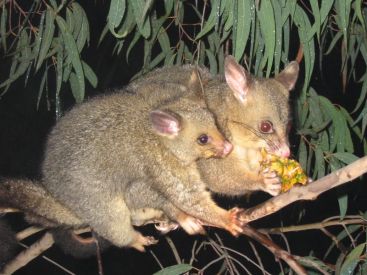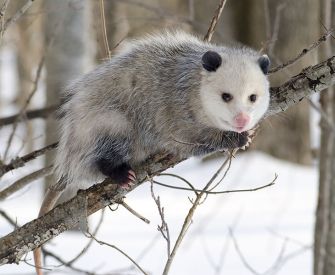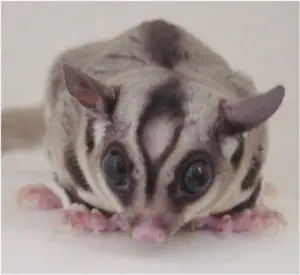Marsupials have different tooth types depending on what they eat, which can range from bugs to other smaller mammals or birds to fruit and seeds to eucalyptus leaves. Omnivores include bandicoots, Australian possums, and American opossums. Herbivores include wombats, kangaroos, and koalas.
What do possums eat?
Table of Contents
The Possum has over 60 individual species that make up the possum family in the Eastern Hemisphere. By a large majority the Possum is an arboreal creature; meaning they primarily live in trees. Possums are omnivores but the mainstay of their diet are fruits and vegetables.
 As seen in the picture, possums will eat pineapple, kiwifruit, apples, flowers, young plants, as well as small insects and most types of human scrap food.
As seen in the picture, possums will eat pineapple, kiwifruit, apples, flowers, young plants, as well as small insects and most types of human scrap food.
Note: The difference between the possum and opossum relates to the hemisphere the animal comes from. Possums come from the Eastern Hemisphere (Asia, Australia, Europe, and Africa). To see the entry for the Opossum please see tbelow, which relates to the animal native to the Western Hemisphere (North and South America).
What do opossums eat?
The Virginia Opossum is the only animal that can properly be called an Opossum. Opossums have an extremely broad diet and are classified as omnivores, meaning they eat plants and animals.
 The primary food source for an Opossum is carrion. In short carrion can be defined as any dead animal.
The primary food source for an Opossum is carrion. In short carrion can be defined as any dead animal.
Other than carrion, Opossums eat all types of small animals such as small birds, frogs, snakes, frogs, maggots and earthworms. The plant life eaten by the Virginia Opossum are fruits, vegetables, and mushrooms. Opossums are also well known to eat any sort of human food, and are particularly fond of dog and cat food.
What do Sugar Gliders Eat?
Sugar gliders are a type of possum with flaps of skin along their arms to help them glide from tree to tree. Because of their small size and affectionate personalities, they are becoming popular pets in America.

If you’re considering a sugar glider as a pet, it’s important to understand their natural diet and how to apply that in captivity. In the wild, sugar gliders are omnivores with something of a sweet tooth. They mostly eat insects and small invertebrates like beetles, spiders, snails and flies, but they also eat the sap and gum of eucalyptus and acacia trees, as well as honeydew, nectar and pollen.
As pets, sugar gliders can be fed crickets and mealworms, which are available at most pet stores, and then one fruit per day such as apples, bananas, grapes or melon. To keep things interesting, try also feeding meaty baby foods, yogurt or boiled eggs to your sugar glider.
What do Koalas Eat?
Koalas are Australian herbivores that eat only one type of plant. They cling to eucalyptus trees with their powerful paws and eat leaves all day long. Eucalyptus leaves have very little nutritional value and are actually toxic to most animals, meaning koalas have almost no competition for them. They compensate for the lack of calories in their diet by having very slow metabolisms. A typical koala will actually sleep for up to 18 hours a day!
Different koala communities prefer different species of eucalyptus trees, which include the swamp gum, blue gum, tallowwood and red river gum. When a koala decides it is time to make for a new tree, it will descend to the ground and walk on all fours to the nearest eucalyptus tree. Sometimes koalas will eat leaves from other trees as well, such as acacia trees and trees from the myrtle family.
What do Kangaroos Eat?
Kangaroos are herbivores, which means they eat mostly plants and plant material. Because of their specialized digestive systems, they can obtain all of the nutrients they require from the plants in their environment. Kangaroos eat grasses, shrub and bush leaves, ferns, flowers, moss, and, on rare occasions, insects. Read More about what Kangaroos Eat.
